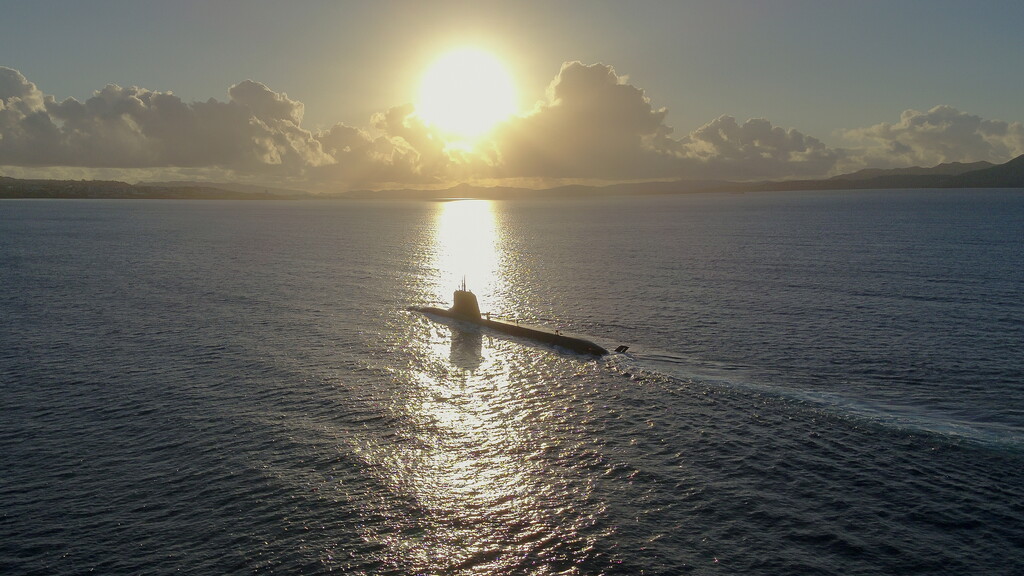On Thursday, April 4th, the Chief of Staff of the French Navy (chef d’état-major de la Marine, CEMM), Admiral Nicolas Vaujour, announced the operational readiness of the second new-generation multi-purpose nuclear-powered submarine of the Suffren class, FS Duguay-Trouin (S636), built as part of the Barracuda program. Previously, the vessel underwent sea acceptance trials starting from March 27, 2023.
I announced today the commissioning of the Duguay-Trouin, the second submarine of the Suffren class. Faster, more enduring, more versatile, more discreet. In the hands of our crews, it will become an outstanding hunter for future operations, wrote Admiral Nicolas Vaujour on his profile on platform X.
The keel for FS Duguay-Trouin (S636) was laid on June 26, 2009. The vessel was named after the French corsair and admiral René Duguay-Trouin (1673-1736) and will be the eleventh unit in the Marine Nationale to bear his name and the first submarine. It thus joined the prototype FS Suffren (S635), which entered service in the Marine Nationale on November 6, 2020.
On November 26, 2021, the ship was rolled out of the assembly hall for the first time, and docking tests were conducted. The launching took place on September 9, 2022, while on September 30 of the same year the main propulsion of the vessel, namely the K15 nuclear reactor supplied by TechnicAtome, was first activated under the supervision of the French Alternative Energies And Atomic Energy Commission (Commissariat à l’énergie atomique et aux énergies alternatives – CEA). Subsequently, preparations for sea trials began.
The sea trials included: a test submersion to check the ballast system, underwater trimming, stability, and hull waterproofing; deep dives in the area of Brest; navigation tests on the surface; and then a transition to the Mediterranean Sea for SYCOBS combat system trials and qualification tests of the main armament.
Four more ships of this type are still under construction: Tourville (keel laid on June 28, 2011), which is expected to be delivered between 2024 and 2025 (it left the assembly hall on July 20, 2023). Keels were laid for De Grasse and Rubis in 2014 and 2019, respectively, and they are expected to enter service between 2026 and 2028. The last, sixth ship of the type will be Casabianca, whose keel was laid in 2020 and is expected to be delivered in 2029 or 2030. The ships will remain in service at least until the 2060s.
The Suffren-class ships are being built as successors to the six first-generation nuclear-powered attack submarines of the Rubis class. The first of these, FS Saphir (S602), was retired from service in July 2019. The next, Rubis (S601), was withdrawn in December 2022. The newest ship of the series, Perle (S606), was damaged on June 12, 2020, due to a fire during repair work. It was decided that the damaged bow section would be replaced with an identical one from the decommissioned Saphir, as the need for repair arises from the necessity to maintain combat capabilities in underwater warfare until all Suffren-class submarines are commissioned.
They will be complemented by third-generation nuclear-powered strategic submarines armed with ballistic missiles. Those units, under the program codenamed SNLE 3G (Sous-Marin Nucléaire Lanceur d’Engins de 3rd Génération), are expected to enter service between 2035 and 2050, replacing four Le Triomphant-class submarines at five-year intervals. The construction program was announced on February 19, 2019, and the first unit’s steel-cutting ceremony took place on March 20 of this year (France: Steel cutting ceremony for the first strategic submarine of a new generation).
Description
The Suffren class has a length of 99.5 meters, a width of 8.8 meters, a draft of 7.3 meters, a surface displacement of 4765 tonnes, and a submerged displacement of 5300 tonnes. The propulsion system consists of a K15 pressurized water reactor with a power of 150 MW, two 10 MW turbo-generators, two emergency diesel generators, and an electric-driven pump-jet. This setup will provide a maximum speed of 25 knots. The crew will consist of 12 officers and 48 sailors. There will also be space for a maximum of 15 special forces soldiers with equipment on board.
The ships are equipped with the Sagem/Kelvin Hughes Series 10 CSR navigation radar, two Sagem Series 30 SOM/AOM optronic masts, electronic warfare system, UMS 3000 hull sonar, and two Thales S-CUBE flank array sonars with software. They also have the SEACLEAR obstacle avoidance system, VELOX-M8 tracking, and NUSS-2F Mk2 echolocation. The units will also be equipped with the CANTO-S decoy, Link 11 and 16 communication systems, DIVESAT satellite communication, TUUM-5 Mk2 underwater communication, and PARTNER communication management system.
The armament for the four 533-mm torpedo tubes will consist of a total stock of 24 long-range MdCN (Missile de Croisière Naval) cruise missiles, Exocet SM39 Block 2 anti-ship missiles, and heavy torpedoes F21 Artemis in any combination. The ships will have the capability to deploy sea mines FG29 and anti-aircraft missiles of the MBDA MICA type, also launched from torpedo tubes. The management of weapon deployment will be handled by the SYCOBS (Système de Combat Commun Barracuda/SNLE) combat management system.
J’ai prononcé aujourd’hui l’admission au service actif du Duguay-Trouin, deuxième sous-marin de la classe Suffren. Plus rapide, plus endurant, plus polyvalent, plus discret. Dans les mains de nos équipages, il deviendra un chasseur hors-pair pour les opérations à venir. pic.twitter.com/MzCIvoZHp3
— Chef d'état-major de la Marine (@CEMM_FR) April 4, 2024







Comments
Nobody has commented on this article yet.